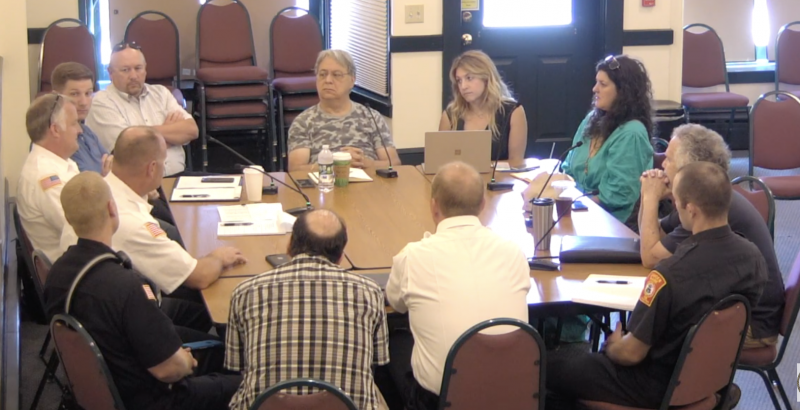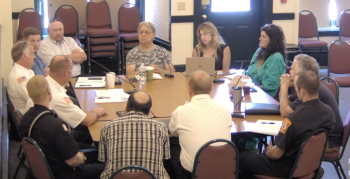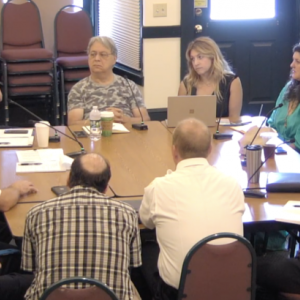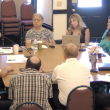Camden, Rockport fire chiefs worried about EMS: Can’t ‘confidently say’ ambulance will show up when called
 The July 30 workshop concerning Camden’s ambulance service was attended by (left to right)Robert Falciani, Camden Select Board chairman; Audra Caler-Bell, Camden Town Manager; select board members Jenna Lookner, Alison McKellar, and Mark Ratner; Camden Firefighter Matt Heath; Rockland Fire Chief Chris Whytock; Camden Firefighters John Ward and Clint Beveridge; Rockport Fire Chief Jason Peasley; Camden Fire Chief Chris Farley; Camden Select Board member Taylor Benzie; and Rockport Town Manager Bill Post. (Photo courtesy Town of Camden)
The July 30 workshop concerning Camden’s ambulance service was attended by (left to right)Robert Falciani, Camden Select Board chairman; Audra Caler-Bell, Camden Town Manager; select board members Jenna Lookner, Alison McKellar, and Mark Ratner; Camden Firefighter Matt Heath; Rockland Fire Chief Chris Whytock; Camden Firefighters John Ward and Clint Beveridge; Rockport Fire Chief Jason Peasley; Camden Fire Chief Chris Farley; Camden Select Board member Taylor Benzie; and Rockport Town Manager Bill Post. (Photo courtesy Town of Camden)
 The July 30 workshop concerning Camden’s ambulance service was attended by (left to right)Robert Falciani, Camden Select Board chairman; Audra Caler-Bell, Camden Town Manager; select board members Jenna Lookner, Alison McKellar, and Mark Ratner; Camden Firefighter Matt Heath; Rockland Fire Chief Chris Whytock; Camden Firefighters John Ward and Clint Beveridge; Rockport Fire Chief Jason Peasley; Camden Fire Chief Chris Farley; Camden Select Board member Taylor Benzie; and Rockport Town Manager Bill Post. (Photo courtesy Town of Camden)
The July 30 workshop concerning Camden’s ambulance service was attended by (left to right)Robert Falciani, Camden Select Board chairman; Audra Caler-Bell, Camden Town Manager; select board members Jenna Lookner, Alison McKellar, and Mark Ratner; Camden Firefighter Matt Heath; Rockland Fire Chief Chris Whytock; Camden Firefighters John Ward and Clint Beveridge; Rockport Fire Chief Jason Peasley; Camden Fire Chief Chris Farley; Camden Select Board member Taylor Benzie; and Rockport Town Manager Bill Post. (Photo courtesy Town of Camden)
CAMDEN — Informally and without any official votes, the Camden Select Board, its town manager and fire chief nonetheless agreed July 30 that the town is worried about the capacity of current emergency medical services for its citizens, and will be contacting its municipal attorney about contractual issues with the privately owned ambulance provider — “to raise the red flag, not the orange,” said Camden Select Board Chairman Bob Falciani.
He was speaking toward the end of a workshop held in the John French Meeting Room to assess the existing ambulance service with North East Mobile Health Services, an EMS company based in Scarborough and which maintains a field center in Rockport to serve Camden, Hope, Lincolnville and Rockport.
Falciani said the goal is to set up a meeting with Rockport, “because it is urgent,” said Camden Select Board Chairman Bob Falciani.
Rockport’s Town Manager Bill Post was at the meeting, as was Camden Fire Chief Chris Farley, Rockport Fire Chief Jason Peasley, Rockland Fire Chief Chris Whytock, Camden firefighters Clint Beveridge, Matt Heath and John Ward.
Meanwhile, Butch Russell, North East’s CEO, watched the recording of the meeting over the weekend, and had his own responses to the statements made about the performance of his company, saying any attempts to improve service, talk with local public safety officials, or obtain data from Knox Regional Communications Center, the area’s dispatch service, have been met with resistance.
According to Caler-Bell, North East has yet to be contacted about the potential contract disputes. The Camden Select Board agreed that North East had to be invited “to the table” to respond.
North East has a $299,000 2019-2020 contract with the four towns, and services the communities. It also services Pen Bay Medical Center, which is part of the Portland-based nonprofit network of hospitals and physician offices known as Maine Health.
That hospital work, Russell said, is a critical part of the North East business model, and involves patient transfers from Pen Bay Medical Center to Maine Medical Center in Portland.
In Rockport on Route 1 approximately one mile north of the hospital, North East has based 20 full-time employees, and three ambulances, said Russell. Both the hospital work and the contract with the four towns for EMS service are vital to his business.
“The two together, plus the subsidy [from the taxpayers of the four towns] make it work,” he said.
But the fire chiefs of Camden and Rockport differ and say the level of service currently provided by North East is not working.
The July 30 workshop was the first such focused conversation about Camden’s EMS since last winter, when talk about establishing a different EMS service model first surfaced. That’s when the area fire chiefs and town managers presented an alternative model that includes joining Camden and other towns with Rockland for a regional municipal service. (Read Midcoast towns consider creating own regional ambulance service)
The four towns have contracted with North East for the past six years, ever since Camden First Aid, a local nonprofit EMS service, financially collapsed. Both Camden and Rockport recently signed one-year contracts with North East that end June 30, 2020, while Lincolnville and Hope have signed two-year agreements with North East.
But there are three rising issues for Camden, and have been articulated by Town Manager Audra Caler-Bell.
They are:
1) Systemic. Does the privately owned EMS service model provide Camden with the best response and service, or would a regional, municipally owned operation be better for the community? That is the crux of looking at the alternative model as presented last winter by the fire chiefs to all four towns at select board meetings.
“We’re are going to look at all of it,” said Caler-Bell, Aug. 5.
2) The existing North East contract, and enforcing current agreements, “to address any issues that are serious and to make sure we are providing as good a service for the time being,” she said.
3) And, are there addenda to incorporate to the existing contract and what are the associated costs? she said.
Camden will schedule a meeting with the Rockport Select Board to talk further about its issues concerning North East, and then meet with the Lincolnville and Hope to have a four-town conversation. The latter is to be convened by what is supposed to be the Ambulance Review Committee. That committee consists town managers from the four towns, as well as select board representatives.
That committee has not met since early in the winter of 2019.
EMS concerns
At the July 30 meeting, both Camden and Rockport fire chiefs cited ongoing communication, operational and delivery concerns about the North East Mobile Health Services.
In a joint memo (see attached for the complete memo) from Farley and Peasley and addressed to Camden and Rockport select boards, they outlined specific incidents to substantiate their concerns, including a recent car/bike accident on Route 17 in Rockport, at which, the chiefs said:
“A NEMHS ambulance advised they were not able to answer the call and requested mutual aid. The dispatcher at Knox Regional Communications Center asked the status of other ambulances since they did not know. KRCC was provided the information that one ambulance was busy on a local inter-agency transfer and the other ambulance, which was assigned to our area from Brunswick, was busy on a long distance inter-facility transfer. This is typical n that the inter-facility transfers, which are profitable, are a priority for NEMHS.”
The chiefs presented another incident concerning a June 14 structure fire in Hope when ambulances were unavailable because they were on transfers.
The back-up for North East in these cases, and others as cited in the memo, is Rockland EMS, which sends ambulances to help rescue victims.
“While reliance on mutual aid is acceptable and expected, to a certain extend, the issues with North East is that they do not communicate when they plan to be outside the region to allow us and our regional public safety partners the opportunity to plan for these gaps in coverage,” the chiefs wrote.
There is a, “laundry list of serious incidents when NE has not shown up for calls,” said Peasley, at the July 30 meeting.
He and Farley said North East was relying on Rockland when they are transferring patients to other medical centers from Pen Bay Medical Center.
The chiefs cited a four-hour stretch during the last week of July when North East, “was not in the area, but was on transports,” said Peasley. “No one was informed that a single ambulance would not be here.”
“The big thing to remember is that this has been going on for five years, now,” said Peasley. “Each year has progressively gotten worse and worse. The communication has gone from little to almost absolutely none. They cannot staff ambulances up here on a regular basis. That is the biggest concern that people should be looking at. They are bringing up ambulances regularly from Brunswick to fill the void. They are relying on Rockland weekly because they are out on transfers.”
Farley said the towns are, in response and in effect, creating their own back-up system.
“If I had been asked in 2012 or 2013 what we should be doing, this would have been my suggestion, that we do something collaboratively with the other towns,” he told the Select Board at the July 30 workshop. “Chief Whytock has coined it, ‘we have created our own mutual aid system.’ We are creating our own back-up system by doing this. To me, much the same that Camden and Rockport are doing with their police chief, we should be doing more sharing of our fire services, and doing it collaboratively. We are heading further in that direction and this just takes it further down that road. It gives us the opportunity to look at our whole apparatus replacement schedule and how we make it more cost effective based on the personnel we currently have.”
Response time
The chiefs also said that the North East response time to incidents was lagging.
“Fifteen percent of the time they have not met response time requirements of the agreement,” said Farley.
That agreement is “interesting,” he said.
“The agreement we currently have is that the RCC dispatches them and then they arrive on scene,” he said. “The national standard is that the the call begins when RCC dispatches them and they arrive on scene. The agreement in place is that the call begins when they acknowledge the call.”
For Camden, that is supposed to be nine minutes, he said. The clock effectively starts when they acknowledge the call to when the ambulance crew arrives on scene, he said.
Using the national standard, however, puts them at 29 percent of the time behind what’s expected, he said.
At the workshop, the Camden Select Board talked for almost two hours about the complaints and potential violations. The members agreed, though did not take a vote, to contact Town Attorney Bill Kelly to address the contractual issues, and to have Caler-Bell talk with North East about making improvements to the current state of affairs.
The goal is to inform North East that they have the chance to put its best foot forward under the existing one-year contract, she said.
Board member Benzie said the discussion is philosophical, and reflects whether the town wants to go with a private service or enter into a partnership with Rockland, and other towns, and “to determine what we feel the acceptable level of service is.”
As the conversation trended toward defining what levels of EMS and paramedic training Camden hopes to see on its ambulance, Board Chairman Bob Falciani steered the the talk back to the points at hand, which was to understand more clearly what the current service lacked.
“We have an obligation to provide a high and consistent level of service,” Benzie said. “The conversation is what is the acceptable level of service. All four [towns] might not agree on what is an acceptable minimal level of service.”
By the end of the workshop, Benzie said: “If we can collaborate with our four towns and make it work collectively, that is a great scenario.... The reality is, is we couldn't come to agreement with the four towns of what the minimal level of service should be for EMS [during the Spring contract negotiations with North East]. I am not satisfied with the level of service right now in EMS. We have an obligation to find a way to improve that. Talking with our partnering towns is important and if we can find a way for all four of us to work together, then that’s perfect. If we go down the road with us having different views of minimum level of services, we have to be willing to say, ‘maybe this is not something that we partner as four towns on.”
North East Mobile Health Services responds
Over the weekend, Russell said he watched the recorded workshop and on Aug. 5, he countered statements made there.
“We absolutely are meeting the contract,” said Russell.
The response time, he said, has been met, “every single month” and North East is “still meeting the staffing level.”
He said there are three ambulances in Rockport with 20 full-time employees there.
Russell said the requisite response time in the contract is an average.
“We are going to have trips more than nine minutes,” he said. “That’s how averages work. I’m not sure where they see that as a failure of the contract.”
The contracts for each town are different, as are the requisite average response times; Rockport and Camden are nine minutes; Lincolnville, 19 minutes; and Hope, 17 minutes, he said.
As for relying on Rockland for mutual aid when transferring patients elsewhere, Russell said: “We respond to 96 to 97 percent of the calls, and rely on Rockland 3 to 4 percent. The relationship between us and Rockland is fantastic. The two services for mutual aid are the best set-up for the county [Knox] in years. No service can run without mutual aid.”
He said, “It seems like we are criticized every time we have to use mutual aid.”
Russell also said the 11-month effort by Rockport and Camden to obtain data about EMS calls from Knox Regional Communications Center, the county’s dispatch in Rockland: “illustrates the problem we have with Knox County. They cite 11 months and we have six years. We ran into same problems of obtaining data on several occasions over six years, the life of our contract. Knox County did not share [data], saying it was too much work to pull the data.”
He said North East relies on its own data, which is obtained via its primary dispatch center, Medcomm, based in Bangor. That private dispatch works for ambulance services in northern Maine, as well as North East.
North East relies on Knox RCC for the initial 911 calls, which tones out for an ambulance.
“Every large service has its own center,” said Russell. “That’s different from what Knox County does, which takes the call. There are two different systems. Knox tones it out and waits for a response from our crew. Our dispatch center [Medcomm] gives assistance to the crew and provides resources.”
Russell questioned why Knox County refused to dispatch directly to Medcomm.
“We were trying to get Knox County to call our dispatch center, but was met with resistance,” he said.
“We have always relied on our dispatch numbers,” he said, a point that was discussed two years ago with the Ambulance Review Committee.
The communications with the committee have deteriorated since Winter 2019, after the towns began weighing the creation of their own EMS system. He said North East’s director of operations Director Joe Conley, “ has tried to meet with them but met with resistance.”
Russell repeated that phrase, “met with resistance,” on several points, including the North East attempt, he said, to have discussions about better coordinating with local fire departments about mountain rescues.
“When we bring things up always met with resistance,” he said.
More specifically, he was responding to the fire chiefs’ assessment of a July 3 mountain rescue, when, according to the chiefs’ memo: “a call for an unresponsive teen on a trail in Camden Hills State Park, the crew, which included a paramedic, spent time looking for the patient themselves. They went to several different locations looking for the patient. After being unsuccessful in locating the patient, they requested assistance from Camden Fire. The Chief, who responded from home, was the first public safety person to determine the location of the patient and arrive at his location. A lack of local knowledge and knowing when to request assistance delayed the arrival of EMS care to this patient.”
Russell said North East has an allegiance to the taxpayer, and questions what the alternative proposed municipal model might cost.
He noted that he is the president of the Maine Ambulance Association and said recent legislation secured new MaineCare reimbursement rates for transports to hospitals, so that EMS services will be, come January 2020, losing 15 percent, not 50 percent.
“I get it in the end,” said Russell. “They kept asking [at the July 30 workshop], why are we doing this? They go back to response time, and go to ‘we need more firefighters,’ which is why they are doing this. At the end of the day, it’s about the taxpayer.”
According to Chiefs Farley and Peasley, they want to create a cost-effective EMS system for the community, as well.
“The era of sirens on top of firehouses calling local business owners, tradespeople, millworkers, etc., is long gone,” they wrote in their memo. “The number of ‘volunteer/part-time/on-call’ Firefighters has steadily dwindled for decades across the country. Collaborating with other communities and adding cross-trained Firefighter/Paramedics to the staffs of our towns can ensure that responses will be met. It will ensure that 911 requests for service are a priority over inter-facility transfers. As we see fewer volunteer/part-time/on-call Firefighters, this is a way to supplement these needs. Will a collaborative service with several communities provide challenges? Yes. Will we be challenged to find the numbers of people we will need to hire? Yes. Should we let those challenges limit our desire to explore options? In my professional opinion, I think those challenges add to the excitement of making this work and ensuring that our community receives the level of service it expects from its public safety professionals.
“The current state of EMS delivery is alarming to your local public safety professionals. We want to make a change. We want to create a system which is cost-effective and responsive to the needs of community.”
Russell said Aug. 5 that he would be emailing Caler-Bell that day; likewise, Caler-Bell said she was to be in contact with North East.
Reach Editorial Director Lynda Clancy at lyndaclancy@penbaypilot.com; 207-706-6657.
Event Date
Address
United States

























